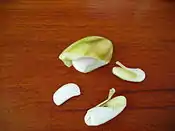Mango oil
Mango oil, mango kernel fat,[1] or mango butter is an oil fraction obtained during the processing of mango butter. Mango oil is a seed oil extracted from the stone of the mango, the fruit of the Mangifera indica tree. The oil is semi-solid at room temperatures, but melts on contact with warm skin, making it appealing for baby creams, suncare balms, hair products, and other moisturizing products. The oil is a soft yellow color with a melting point of 32–42 °C (90–108 °F).
| Saturated fats | |
|---|---|
| Total saturated | 45-50 |
| Unsaturated fats | |
| Total unsaturated | 50-55 |
| Monounsaturated | 40-46 |
| Omega-6 fatty acids | 3-4 |
| Properties | |
| Melting point | 32–43 °C (90–109 °F) |
| Solidity at 20 °C (68 °F) | semi-solid |
| Iodine value | 32.0-60.7 |
Extraction
Fat is extracted from dried mango kernels by hydraulic pressure,[2] or by solvent extraction.[3] In solvent extraction, hexane, a liquid hydrocarbon, is used as the extraction medium. The collected mango stones are washed with well-water soon after collection. After washing, the seeds are sun dried to reduce the moisture content to 12-15%. The dried seed stone is roasted in a drum roaster and the hull is removed mechanically, or manually by beating with wooden clubs. The separated kernels are crushed into small pieces in a hammer mill. The mango kernel pieces are conveyed to a pellet making machine and pellets are formed. The pellets are cooled to room temperature in a cooler and are conveyed to the solvent extraction plant. Some processors produce flakes by crushing the seeds in a flaking roller mill.[4]
Composition and characteristics of oil/fat


Mango kernel oil is solid at room temperature with a melting point of (35–43 °C (95–109 °F)).
|
Physical characteristics of mango kernel oil[5]
|
Fatty acids present in mango fat[6]
|
Uses
- Can be used as a substitute for cocoa butter in chocolate manufacturing.[1][7]
See also
References
- Jill Frank (Oct 24, 2014) "Cocoa Butter Alternatives in Chocolate", Prospector, Underwriters Laboratories
- Mango oil extraction
- Extraction methods
- Solvent extraction of vegetable oils Archived 2013-10-06 at Archive.today
- SEA Hand Book 2009, Solvent Extractors' Association Of India
- SEA :SEA News circular Vol.2 No.3 (June 2009)
- Production of a cocoa butter equivalent